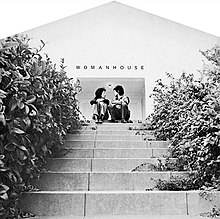Miriam Schapiro | |
|---|---|
 Front page of the exhibition catalog for Womanhouse, photograph by Sheila Levrant de Bretteville | |
| Born | November 15, 1923 |
| Died | June 20, 2015 (aged 91) Hampton Bays, New York, United States |
| Nationality | American |
| Education | BA, University of Iowa (1945), MA, University of Iowa (1946), MFA, University of Iowa (1949) |
| Known for | Painter, Printmaker, Collagist, Femmage artist |
| Movement | Abstract Expressionism, Feminist art, Pattern and Decoration |
| Spouse | Paul Brach |
| Awards | College Art Association Distinguished Artist Award for Lifetime Achievement (2002) |
Miriam Schapiro (also known as Mimi) (November 15, 1923 – June 20, 2015) was a Canadian-born artist based in the United States. She was a painter, sculptor, printmaker, and a pioneer of feminist art. She was also considered a leader of the Pattern and Decoration art movement.[1] Schapiro's artwork blurs the line between fine art and craft.[2] She incorporated craft elements into her paintings due to their association with women and femininity. Schapiro's work touches on the issue of feminism and art: especially in the aspect of feminism in relation to abstract art. Schapiro honed in her domesticated craft work and was able to create work that stood amongst the rest of the high art. These works represent Schapiro's identity as an artist working in the center of contemporary abstraction and simultaneously as a feminist being challenged to represent women's "consciousness" through imagery.[3] She often used icons that are associated with women, such as hearts, floral decorations, geometric patterns, and the color pink. In the 1970s she made the hand fan, a typically small woman's object, heroic by painting it six feet by twelve feet.[4] "The fan-shaped canvas, a powerful icon, gave Schapiro the opportunity to experiment … Out of this emerged a surface of textured coloristic complexity and opulence that formed the basis of her new personal style. The kimono, fans, houses, and hearts were the form into which she repeatedly poured her feelings and desires, her anxieties, and hopes".[3]
- ^ Cotter, Holland (January 15, 2008), "Scaling a Minimalist Wall With Bright, Shiny Colors", New York Times, retrieved September 12, 2009
- ^ Gipson, Ferren (2022). Women's work: from feminine arts to feminist art. London: Frances Lincoln. ISBN 978-0-7112-6465-6.
- ^ a b Cite error: The named reference
:1was invoked but never defined (see the help page). - ^ Stein, Linda (1998). "Miriam Schapiro: Woman-Warrior with Lace". Fiberarts (24): 35–40.